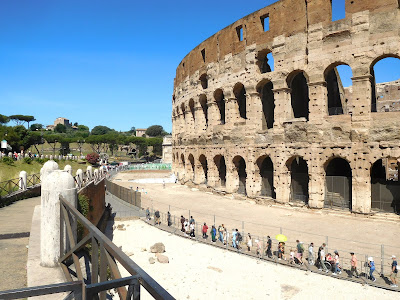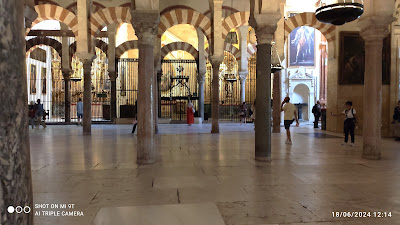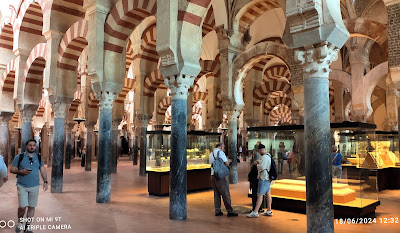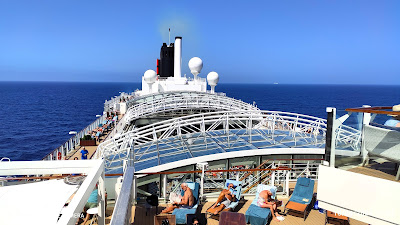The lad and I had stopped at the High Rocks, after finding the Huntsman at Eridge, our intended port of call, closed due to a power outage. It had been a decade or more since the last time I’d set foot in the High Rocks, and whilst a visit there was long overdue, there was another motive for us calling in at the pub. That reason was that Heidi, the youngest of Eileen’s two nieces would be marrying her fiancé Phil there, at the beginning of July 2024. So, last Friday, which was just under a year following on from our visit, the day of the wedding finally arrived.
I mentioned in a previous article that there was a family connection with the High Rocks, as attached to the main building, is a magnificent, oak-beamed barn, used to host larger functions at the High Rocks. The barn was assembled by Heidi’s late father, Brian, after starting life as an old farm building. It was acquired by the owner of the High Rocks, and then taken apart, and transported to its new site, for reassembly. It was quite a project, and Brian was rightly very proud of it.Brian sadly passed away four years ago, right at the beginning of the pandemic, although his death was not COVID related, so was not there to give his youngest daughter away. That honour should have passed to Heidi’s son but, as sometimes happens in families there was a bit of a family falling out. I won’t go into detail, especially as they aren’t relevant to this post, but the long and the short of this is, Matthew was asked to step in, and take the place of his second cousin.
Matthew was honoured to accept his cousin’s request and come the day Eileen and I were very proud of the way that performed, carrying out his duties flawlessly, and looking every bit the part in his hired suit. I had to drive him down to the bride and groom’s house at Uckfield, earlier that morning, so he could travel up to the High Rocks with Heidi, in the bridal car. There was a pay-off here, as it meant with Matthew’s car still at our place, he could then drive me over to the High Rocks the following morning. I could then collect my vehicle, which we would be leaving there overnight, having booked a taxi to pick us up after the wedding. All very complicated, but it worked!
Eileen and I arrived early at the High Rocks, as the usual and expected heavy traffic through Southborough and St Johns, failed to materialise. We weren’t the only early arrivals, and after parking the car in the large car park, just opposite the pub, met up with friends and other family members. There was time for a drink before the ceremony, or so I thought, as did several other people, but I was halfway through my pint of Tonbridge Rustic, when the Master of Ceremonies came along and asked us to file into the room where the wedding would be taking place. Fine, we thought, until the MC also informed us that no glasses were permitted inside the hall during the ceremony.The wedding passed off well, and as mentioned earlier, Matthew gave his cousin away without a hitch, if you’ll excuse the pun. After the ceremony and the signing of the register were complete, we all trouped outside and across the road to the High Rocks themselves, where the wedding photos were to be taken. In the meantime, our absence from the hall would allow staff to get all the tables set out and laid, ready for the wedding breakfast. (Why is it described as a breakfast?) This occasion was the first time that I’d seen the actual High Rocks, close-up, and I have to say they really are impressive.
You can see what I mean from the photos, but as far as the wedding was concerned, these imposing, rocky outcrops formed the perfect backdrop for the various bridal and wedding party photographs. Photos over, we filed back across, and found our allocated places around the well-laid out, circular tables. Matthew was on the top table, but company wise Eileen and I definitely got the bum deal, as we were stuck with some of the most boring people imaginable, who spent most of the time discussing their various ailments. If this is what growing old really means, then put me down now! By way of compensation, we enjoyed an excellent roast beef dinner. I also got stuck into the wine, during the meal, but I was the only person drinking the red stuff. I didn’t finish the bottle, particularly as there were glasses of bubbly to toast the happy couple, during and after the inevitable speeches. I carried on with the wine, for a while, as the cask choices - Rustic from Tonbridge Brewery and Flintlock from Musket Brewery, didn’t really appeal to me. I’m becoming ultra fussy in my old age, but my consumption of wine caused Mrs PBT’s to raise her eyebrows. She claimed that the taxi driver wouldn’t let me in the cab, if I was drunk, but the only thing the prosecco and red wine did was to make me feel thirsty. I solved the conundrum by switching to Guinness Zero, as the evening wore on, and that provided sufficient taste without the risk of me getting sloshed.There was the inevitable disco, playing the same old records for those who like to “dad dance”, but there was other entertainment in the form of a magician – who came round to each table, plus a fully laid out gambling area, where guests could play roulette and other gaming activities that mean absolutely nothing to me. Fortunately, the stakes used fake money only, and it was here that master Matthew showed his gambling prowess by accumulating a substantial pile of chips.
As the evening wore on, people began to gradually drift off, but as my good lady had mis-judged the finish time, and had booked the taxi for an 11.45 pick-up, the three of us were virtually the only people left by the time our driver arrived. I did suggest phoning the taxi company earlier, and request a change of pick-up time, but with no mobile signal at the High Rocks, and an automated booking that Eileen had made, earlier in the week, we stuck it out, by waiting in reception. I can imagine the fuss that would have ensued, if I had made an error on the booking, but it didn’t really matter, and it certainly didn’t spoil what had overall been an excellent, and very enjoyable, family occasion.









































 I've already posted an article about
I've already posted an article about 











